Content |
|---|
History
The St. Bernard It is a breed of dog whose name in other languages: St. Very, Bernhardiner, Chien du Saint-Bernard, Saint Bernard Dog.
According to breed historians, the St. Bernard, descended from the ancient molossians Asian, whose ancestral form was and is represented by the Tibetan Mastiff.
A team of researchers from the University of Manchester, directed by Chris Klingenberg of the Faculty of biological sciences, reviewed 47 skulls of St. Bernard donated by Swiss breeders to the Natural History Museum in Bern covering a period of 120 years, from modern copies until those old dogs of the time that was initially defined the standard of the breed. It was found that the traits stipulated in the breed standard of the St. Bernard have become more exaggerated over time, as breeders selected dogs that had the desired physical attributes.
Compared to their ancestors, the St. Bernard modern has the widest skull, the angle between the nose and the forehead more pronounced, and also a more significant bump over the eyes. These changes are described exactly as desired in the breed standards. Clearly, not due to other factors such as overall growth, since they do not provide the animal with any physical advantage, so we can be sure of have evolved only by selective breeders considerations.
This research shows how the selection, either natural or in this case artificially influenced by the man, It is the fundamental driving force behind the evolution of life on the planet.
In the year 923 born Bernard of Menthon in Menton, region of Savoy (France), which he became Archdeacon of Aosta, in the Italian Alps, dedicated to spreading the Christian faith among the inhabitants of the Alps. In one of these Alpine passes was founded in the year 1049 the Hospice of the Gran San Bernardo, to help, help and shelter to hikers who were the step. The Holy, Catholic scholar and theologian, He was part of the Cistercian order or better known as Trappist, as fellow (the Trappist monks) in Switzerland they had a dog of this breed as a companion around the 16th century.
In the great Mount St mountain pass. Bernhard, to 2.469 meters above the sea level, monks founded in the 11th century, a hospice for travellers and pilgrims. there they were raised, Since the mid-17TH century, big mountain dogs for guard and surveillance. The existence of those dogs is documented graphically from 1695 written in a chronicle of the Hospice from the year 1707.
These dogs were soon used as guard dogs and, especially, as rescue dogs for travellers lost in the fog and snow.
There are Chronicles published in many languages over the many lives were saved by these dogs in the “White death” and stories of soldiers who crossed the mountain pass with Napoleon Bonaparte to 1800, in the 19th century, they spread the dog's fame for St. Bernard all over Europe.
Already known at the time “Barry Hund“, and the legendary “Barry” became the symbol of the rescue dog. The direct ancestors of the dog of St. Bernard were the very widespread oversized dogs, peasants of the region. These large dogs became only a few generations, an ideal pattern, in the current race.
As a result of an international cynological congress held on 2 in June of 1887, the dog of St. Bernard was officially recognized as a Swiss breed and the breed standard became mandatory. Since then St. Bernard dog was converted in the “Swiss national dog”.
Heinrich Schumacher Holligen, was the first, in 1867 creating genealogical documents for their dogs. In February of 1884 opened the “Schweizerische Hundestammbuch” (Swiss races book, SHSB). The first entry was that of St. Bernard “Leon”, followed by other 28 annotations also of dogs of St. Bernard. The 15 in March of 1884 was founded the “Schweizerische St. Bernhardsclub” (Swiss Dog Club St. Bernard) in Basel.
Physical characteristics
The Saint Bernard, is classified in the Group 2: Dog type Pinscher and Schnauzer, Molosoides and mountain dogs and Swiss Cattle Dogs, and other races; section 2; Molossoid, 2.2 Type mountain (without working trial). Of the FCI (Federation Cynologique Internationale).
There are two varieties of the dog St. Bernard:
- The variety of short hair (double hair, Stockhaar).
- The long-haired variety.
Two varieties are of great stature and of a noble general appearance; they have a vigorous body, robust, harmonic and muscular, as well as an imposing head with an expression of attention on the face.
The cross appeal is, minimum of 70 cm for males and 65 cm for females. The FCI standard sets a maximum of 90 cm for males and 80 cm for females (dogs exceeding the maximum height is not devaluarán if its general aspect is harmonic and its proper motion).
In general the size is defined as:
- “Very large“, to be optimal in San Bernardo, When exceeds the 86 cm in males and the 80 cm in females.
- “Grand” When going from 82 to 86 cm in males and 75 to 80 cm in females.
- “Media” When going from 78 to 82 cm in males and 70 to 75 cm in females.
- “Small” When going from 70 to 78 cm in males and 65 to 70 cm in females.
In it "golden period of St. Bernard” (1920-1940) were very rarely seen in exposures lower males to 80 Switzerland cm, of Germany, in the Netherlands and the subjects were not so rare above the 90 cm..
Also currently a good San Bernardo to access the championship would never have to be -with some exceptions- below the 80-82 cm and abundantly exceed such limit to reach above if possible the maximum of the German Mastiff and of the Irish Wolfhound but with greater volume, greater length of the trunk and heavier, course.
Character and skills
The dog's St. Bernard radiates calm and tranquility. He is balanced and self-confident.. Despite its imposing size, it is sensitive and has a gentle nature. Its “obstinacy” is typical of this breed, not only in appearance. The St. Bernard is trustworthy and kind, even with strangers. There is hardly a dog that has such a tolerant and balanced nature. Quietly he lets himself be caressed and understood by children he does not know. There is hardly a dog as fond of children as the St. Bernard. Nothing seems to bother him.
But, has an alert protective instinct. Defends his family and territory inflexible and extremely effective. One St. Bernard healthy and well socialized never loses control. It is not a barking dog and will stop any intruder quietly and abruptly. How do you like to live outside, still suitable as a guard and protection dog – but it is not in any way a dog to be in a kennel. The basis of this is the close connection with your human family, who should be the center of attention. Because he is affectionate and needs a lot of contact with humans as well as with other dogs.. After all, the close connection with his master is the decisive basis of his education.
Due to its size and strength, a St. Bernard a dog is not for beginners. It also, its maintenance is – as with all big dogs – very complex. If you want to buy a dog from St. Bernard, You must first be clear about some basic things:
The extreme dimensions bring with them quite practical problems. This starts with the car. And what if the adult giant is sick or cannot walk for a while due to age?? The St. Bernard not a dog for an apartment. The floor of the house should not be slippery. The dog should not have to climb the stairs frequently. To the St. Bernard he likes to travel; not an athlete, and take it easy. In the interest of your fitness, one should ensure that he exercises outdoors every day. Ideally, a St. Bernard stay in the field.
St. Bernard Education
To have fun with your dog St. Bernard, consistent education from the puppy's age is a basic requirement. 60 and more kilos of stubbornness, reluctantly following instructions, it's not a fun thing. Also keep in mind that the St. Bernard It, in case of doubt, much stronger than any well-trained man.
A deep and intimate bond with your caregiver is the basis of education, never difficulties or coercion. As puppies it must be carried with a stoic consistency. In his youth, the St. Bernard they are usually very lively and challenge the leadership of their humans. But, the dog of St. Bernard can be well educated. His calm and kind nature even forgives this or that mistake. But a solid education foundation with clear rules for daily life is an absolute prerequisite for your future attitude..
St. Bernard health and care
Coat care is simple. Regular brushing is enough. During the change of coat, twice a year, everything is a little more complex.
The main health problem of St. Bernard is the extreme breeding, breeding for gigantism. Puppies and young dogs of such breeding already grow too fast. So, it's about body coordination problems. Epilepsy and other diseases accompany the giant that is becoming. Life expectancy decreases dramatically. The enormous growth and associated rapid weight gain is an extreme challenge for the entire body.. The dog's fingerprint is not designed for such giants. the heads, for more “typical” they seem, they have also been raised to be unhealthy and powerful, which can cause problems at birth.
One should pay attention to the eyes: Droopy eye or droopy eyelid is a widespread problem, especially with particularly powerful heads, that requires lifelong care and can seriously damage the eyes. Professor Distl of the Hannover University of Veterinary Medicine considers the St. Bernard as one of the breeds in which epilepsy is more common. Various types of cancer such as osteosarcoma also appear to be common in St. Bernard. The breed is strongly affected by dysplasia of the hip joint, as well as other skeletal diseases.
Nutrition / Food
Puppies and young dogs, they grow very fast, require expert guidance for proper nutrition. At the same time, attention should be paid to controlled exercise, neither too much nor too little. In the adult Saint Bernard there is a risk of stomach torsion. Otherwise, as with any big dog, the same applies to food: good and hearty.
The life expectancy of a St. Bernard
The legendary Barry I had 14 years, 10 of which he spent them on active rescue service in the Gran San Bernardo. Today is different, made by the man. Today, the St. Bernard is one of the dogs with the lowest life expectancy. The colossi of today reach only 6 to 8 years. Only very rarely does he reach an age of 10 years or more. On the other hand, a St. Bernard raised healthy with a weight lower than 70 kg is a robust dog and, despite its size, very frugal, without problems can live 10 years.
Buy a St. Bernard dog
Before buying a St. Bernard, you should check very carefully if you really have all the requirements to be able to spend many wonderful years with this giant. Only when all this clears up, a breeder must be found and contacted long before purchase. Special importance must be given to the fact that the breeder avoids exaggeration. Dogs in your kennel should not be large or too heavy. Also the heads should not be too powerful. It also, make sure that no epilepsy occurred in the ancestors. In any case, it should be clear that a puppy is only bought directly from a serious breeder. Better pay a few hundred euros more for a puppy from a serious breeder. These euros have a good opportunity to become the best investment of your life. Coming from a serious upbringing, a puppy of St. Bernard costs between 1.500 and 2.000 EUR.
Characteristics "St. Bernard"
Coexistence is important that you have with your new friend. Before considering the acquisition of a dog of the breed "St. Bernard" you know certain factors. Not all breeds of dogs are apt to live in an apartment, you must take into account his character, their need for exercise, their interaction with other pets, their care and if you have small children, their level of tolerance towards them.
Adaptation ⓘ4.0 out of 5 stars (based on 1 review)
|
friendly dog ⓘ5.0 out of 5 stars (based on 1 review)
|
hair loss ⓘ3.0 out of 5 stars (based on 1 review)
|
|---|---|---|
Affection level ⓘ5.0 out of 5 stars (based on 1 review)
|
Need for exercise ⓘ2.0 out of 5 stars (based on 1 review)
|
Social need ⓘ4.0 out of 5 stars (based on 1 review)
|
Home ⓘ3.0 out of 5 stars (based on 1 review)
|
Toilet ⓘ4.0 out of 5 stars (based on 1 review)
|
Friendly with strangers ⓘ3.0 out of 5 stars (based on 1 review)
|
barking ⓘ3.0 out of 5 stars (based on 1 review)
|
Health ⓘ5.0 out of 5 stars (based on 1 review)
|
Territorial ⓘ5.0 out of 5 stars (based on 1 review)
|
Cat friendly ⓘ5.0 out of 5 stars (based on 1 review)
|
Intelligence ⓘ3.0 out of 5 stars (based on 1 review)
|
Versatility ⓘ3.0 out of 5 stars (based on 1 review)
|
Child friendly ⓘ5.0 out of 5 stars (based on 1 review)
|
Surveillance ⓘ2.0 out of 5 stars (based on 1 review)
|
joy ⓘ5.0 out of 5 stars (based on 1 review)
|
St. Bernard Images
St. Bernard Videos
Type and recognitions:
- FCI CLASSIFICATION: 61
- Group 2: Pinscher and Schnauzer - Molossoid and Swiss Mountain and Cattledogs
- Section 2.2: Molossoid, mountain type. Without working trial. .
Federations:
- – FCI – Pinscher and Schnauzer-Molossoid type dogs – Swiss Mountain Dogs and Cattledogs. Section 2.2 Molossoid, mountain type. ⓘ
- – AKC – Workgroup ⓘ
- – ANKC – Group 6 (utility dogs) ⓘ
- – CKC – Workgroup ⓘ
- – KC – Workgroup ⓘ
- – NZKC – Utility dog ⓘ
- – UKC – Watchdog ⓘ
FCI breed standard "St. Bernard"
Alternative names:
1. St. Bernhardog, Bernhardinner, Alpine Mastiff (archaic), Saint, Saint Bernard (English).
2. Grand-Saint-Bernard (French).
3. St. Bernhardshund, Chien du Saint-Bernard, Saint Bernard Dog, Perro San Bernardo (German).
4. Cão de São Bernardo (Portuguese).
5. Gran San Bernardo (español).
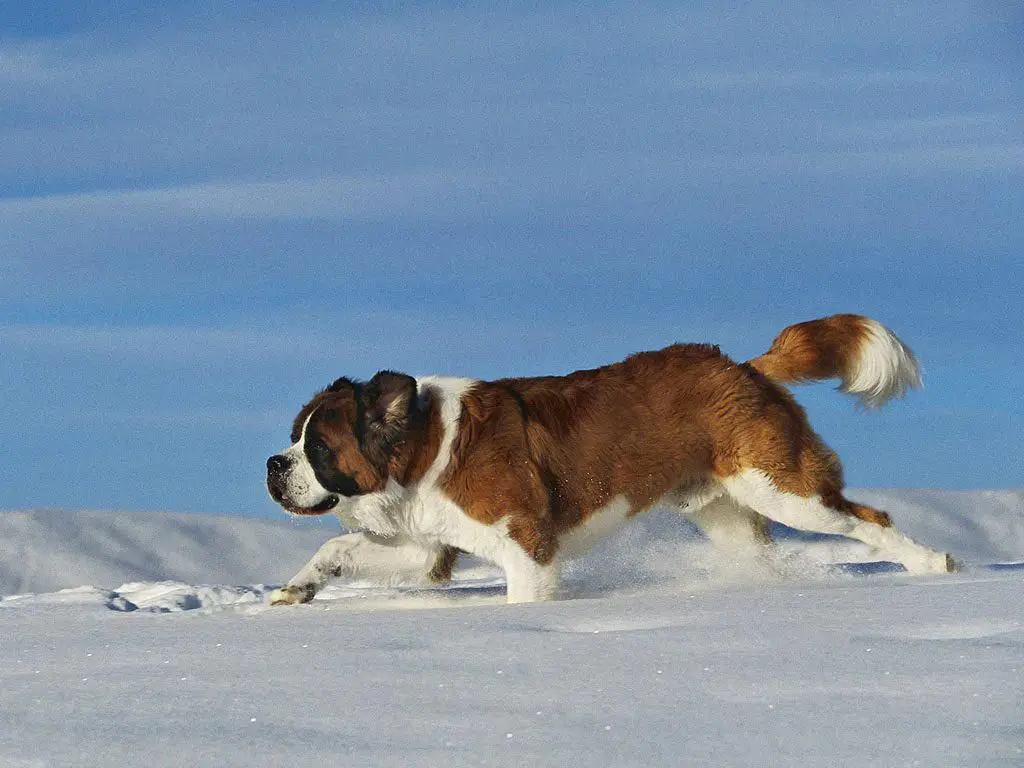

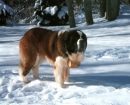

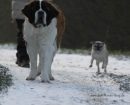
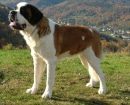




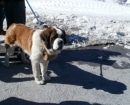
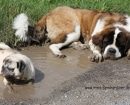
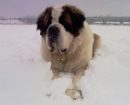
 St. Bernard #02 – puppy love
St. Bernard #02 – puppy love Brody and Bella. bella sharing her peice of ice
Brody and Bella. bella sharing her peice of ice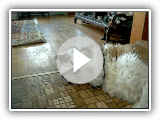 evil kitten attacks saint bernard
evil kitten attacks saint bernard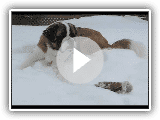 Saint-Bernard – 2 Chiens, 1 Kong
Saint-Bernard – 2 Chiens, 1 Kong